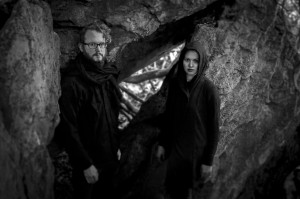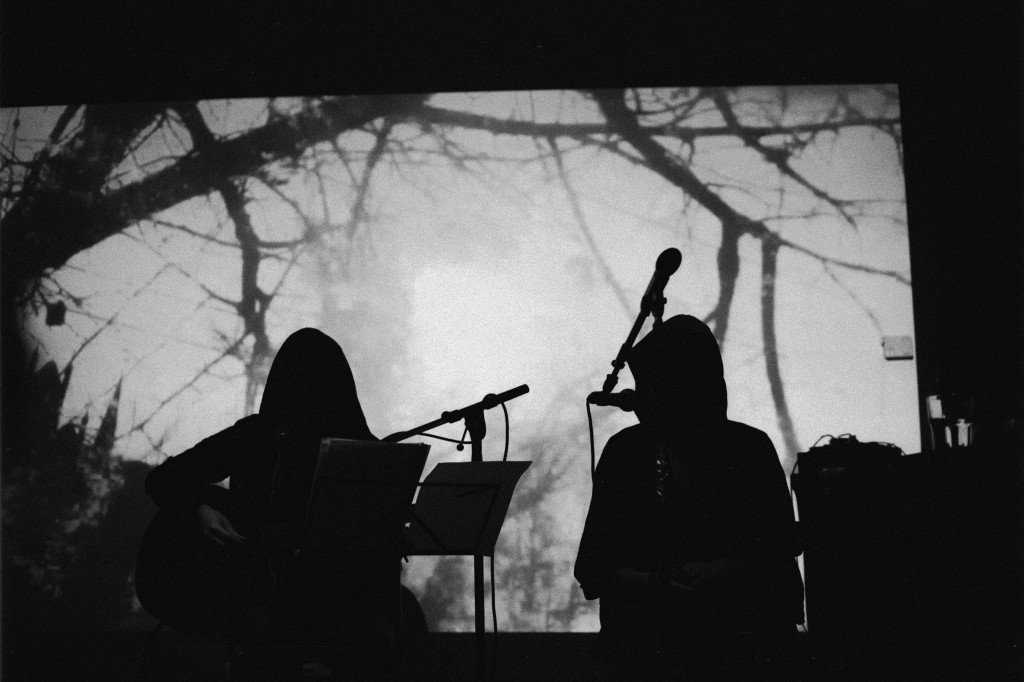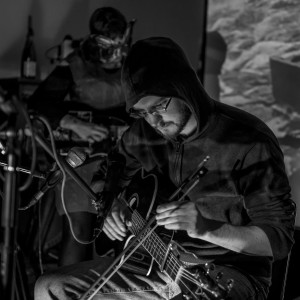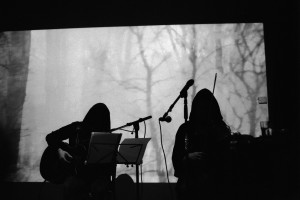 Lost Harbours, the duo consisting of Richard Thompson and Emma Reed, has existed for about ten years. On three albums and a number of smaller releases they play a music that they themselves call “experimental folk”; and this sometimes transcendent music indeed transcends simple categories or genre limitations – maybe the title of the album “Hymns & Ghosts” can be read programmatically. Originally from Southend-on-Sea, Thompson now lives in Latvia.
Lost Harbours, the duo consisting of Richard Thompson and Emma Reed, has existed for about ten years. On three albums and a number of smaller releases they play a music that they themselves call “experimental folk”; and this sometimes transcendent music indeed transcends simple categories or genre limitations – maybe the title of the album “Hymns & Ghosts” can be read programmatically. Originally from Southend-on-Sea, Thompson now lives in Latvia.
Could you briefly say a few words about how and why Lost Harbours started? Did you play in other, stylistically different (or similar) groups before you founded Lost Harbours?
Other than playing bass in a Britpop style band during my teenage years, Lost Harbours has been my main musical creative outlet. It was partly those early musical experiences that drove me towards a solo project. I longed to make music, but felt hampered by playing with people who had very different tastes, desires and working methods. After the band petered out, I started playing piano more and obtained a guitar. At first I used tape players to self record, then mini disc and finally a digital 8 track, on which the demos for the first album ‘Hymns and Ghosts’ were recorded, plus a lot of the other early material. This period coincided with an intense period of exposure to different musical genres and styles. In particular I was digging ‘noise’ a lot, acts like Wolf Eyes, Nackt Insectan, Kylie Minnoise and Smegma, the industrial scene of the 80s and also early James Blackshaw and Grouper.
 You describe Lost Harbours (self-consciously and self-confidently) as an “experimental folk duo”. Abstract patterns and “soundscapes” seem to play a role in your music as much as a traditional, acoustic instrumentation. Did you grow up with English folk music, or if not, in which contexts did you discover it? Do you feel that there has to be a balance between experiment and convention?
You describe Lost Harbours (self-consciously and self-confidently) as an “experimental folk duo”. Abstract patterns and “soundscapes” seem to play a role in your music as much as a traditional, acoustic instrumentation. Did you grow up with English folk music, or if not, in which contexts did you discover it? Do you feel that there has to be a balance between experiment and convention?
I didn’t have any connection with folk music in general until my late teens when I picked up the Incredible String Band’s album ‘The Hangman’s Beautiful Daughter’, plus an Anne Briggs compilation, Bob Dylan and some blues comps from a local second hand record store. At that time I was just looking for anything weird, but not having access to the internet meant my only guides were the NME, Melody Maker, The Wire and other music magazines. Sometimes this meant buying an album based on its cover, which is what happened with the Incredible String Band and also Godspeed You Black Emperor. At the same time I was digging John Martyn a lot, especially Solid Air. The entire ‘Freak Folk’ scene kicked off in the States, which I picked up on – seeing Devendra Banhart play one of his first UK gigs was quite inspirational. Then through a Wire article I discovered Finnish Free Folk and started buying everything I could find from the Fonal Label. So, really, I never properly engaged with traditional English folk music until I had already started making music under the name of Lost Harbours. Most of the formative influences were from America or Europe, bands like Espers, Six Organs of Admittance, Jandek, Devendra Banhart, Popol Vuh, Amon Duul ii, Lau Nau, Paavoharju and Islaja.
Whether a balance is required between experiment and convention is entirely down to what you are trying to achieve, but it’s not something I think about when creating music. I feel that if that is part of your mindset, then you are making music for a perceived market, whereas I’m making music to express myself. Any element, whether ‘experimental’ or ‘conventional’, I add has to, first and foremost, serve the song.
I’ve always struggled with a term that neatly encapsulates what I’m trying to achieve with the project, ‘experimental folk’ seemed to serve as well as any other for a while. It’s very difficult to come up with just two or three words that describe an act the crosses multiple genres. I would imagine there are many people who certainly wouldn’t use the term ‘folk’ to describe the vast majority of what I do, at the same time is what I am making really experimental in the truest sense of the word?
I bought the cassette version of “Towers of Silence” and there are more of the droney elements. You write that there are “extra atmospheric and ambient sounds”. Did you think that the tape was the ideal medium for that? What made you decide to release (slightly) different versions of the album?
For the album to fit onto the vinyl and not lose sound quality I had to remove a lot of the ambient passages. In total, I think I removed about 25 minutes off the original length. Releasing the album on cassette allowed me to still keep the album split in two and retain the original length (almost). Also, I’m really enjoying the current revival of the cassette and wanted to contribute to that in some small way.
 What is the relationship between the more composed songs and the improvised pieces on your albums?
What is the relationship between the more composed songs and the improvised pieces on your albums?
The improvised pieces you refer to have usually come out the rehearsal space, playing with either Emma or Sabine, creating a song that allows for elements of improvisation within its structure, giving it a loose feel. The other method I’ve applied is to just record improvised guitar pieces, then layer on top, working with a ‘first idea, best idea’ approach. There are other songs which seem to just appear fully formed. I try to play guitar every day, sometimes a riff appears and within minutes there is lyrical content and the rest flows together very quickly. Lake was like that, also Morning Song from the first album. The latter written just a few hours before the first ‘proper’ Lost Harbours show.
Artists can be influenced by their surroundings, especially nature, and you recorded an album (”Engures Ezers”) about which you write that it was influenced by a summer hike in North Latvia. Can you tell us something about the development of this album in particular and the role that landscape/nature plays in your work in general?
I’ve always carried a Zoom or similar around on trips and used field recordings as a base element in many tracks – even on the first EP you can hear bird song from central Berlin.
The hike in question was a slightly surreal experience. The rural areas of Latvia aren’t highly populated and it often felt that there was no one around for miles, just us and the mosquitos. On one part of the trek we discovered hundreds of dead dragonflies; they flew past us and slowly drifted into the ground leaving a trail of broken bodies all the way to the lake. I took a number of photos on this hike that enabled later reflection on the experience. I think also the heady melancholia of the environment played a role, the stillness of the clear water, abandoned houses, a boat on the beach with the un-ebbing sea lapping gently at its stern.
I’ve always felt an affinity for quiet natural places and as the time I have to enjoy that sort of environment has diminished, I really value the time I do get. So when confronted with the natural environment I become very inspired.
The album itself was created from found sounds, snippets of radio, samples from cassettes brought in Riga which were then fed through a system of guitar pedals. Whilst the initial tracks were put together quite quickly, it took a year to really hone them. I was working on ‘In the Direction of the Sun’ at the same time, and applying similar techniques, except that album was mainly made from field recordings and copyright free material and attempting to evoke the geography of the Orkney Islands.
With Engure Ezers, for each track I tried to think back to a specific memory of an event, be it staring into the clear waters of the lake or winding my way through thick woodland, and encapsulate the dreamlike quality fading memory has in the song. That loosening of specifics and the oozing of feelings, time and picture into an indistinct impression.
On your latest album you refer to your native Essex as well as to Latvia again and you now live in Latvia. Would you say that the way in which these two places have inspired you is of a very different kind?
Living away from England has caused me to look back and engage more with British folk song. Also, with my trips to the UK now just once or twice a year, I think the landscape makes a greater impression on me now than before, it is refreshed in my mind, new things stand out, new impressions are made, everything feels less familiar. Towers of Silence is my attempt to capture these feelings.
However, on the whole, the way I approach lyric and song writing is still the same whether I’m taking influences from England or Latvia. The type of influences I take from each place are similar.
Richard, as your way of singing sometimes reminds me of sacred chant, have you  ever studied old singing techniques, or have you drawn specific influence from such works in another way?
ever studied old singing techniques, or have you drawn specific influence from such works in another way?
When I was very young my Mum sang in a choir and I’d be regularly taken to her concerts, this combined with my own choir experiences, also time spent listening to Gregorian Chant and Georgian Polyphonic singing has massively influenced the way I sing. I’ve never studied these singing techniques in a formal manner though.
On the above-mentioned “Engures Ezers” there is a track called “Forest Mass” which seems to be a particularly transcendental piece (if you allow such vague a term). Have you any pantheistic leanings? To what extent is your music “devotion” (to quote a song from “Wooden Wires”)?
I’ve never put a word to it. But certainly my music is meant to be worship, of a kind, to nature as a whole, as something uncontrollable and beautiful.
Your latest album starts and finishes with a traditional. Was this framing intentional and what can you tell us about the relevance of these two songs for you and for “Towers of Silence”?
I didn’t have much idea of the track order until well after we had finished the recording process. I played around with different combinations through the process of trimming tracks for the vinyl. It took about 6 months to get everything in order. In the beginning we were going to lead with Lake, feeling that it would be the ‘single’, but somewhere in the process that idea was lost. The two longer tracks needed to be cut down the most, keeping the core song and then swapped around from where I thought they would originally be. I didn’t really have any compunction about moving the tracks around, there wasn’t a grand narrative or anything similar that I was trying to create, but certainly I was aiming for everything to flow smoothly. As I have previously stated, this process took about 6 months.
“Idumea” can also be found on “In the Direction Of The Sun” (in a different form). Why did you decide to use it again?
Simply because it’s one of my favourite songs and I had the chance to do a studio version of it with Diana Collier leading the vocals. We completed this song before even starting to record the rest of the album and were playing it live in various forms prior to that. Diana played with us at the Leigh Folk Festival, and I had some time booked at No Recording Studio and invited her to come in.
“From Beyond” was influenced “by the melancholia and brutal tones of Black  Metal”. Can you say something about how that album came into being?
Metal”. Can you say something about how that album came into being?
I sporadically go through periods of listening to Black Metal, I feel an affinity with the texture and tone of the sound, especially on early Abruptum albums. I felt it could be an interesting direction to go in, even just for a few songs. Any takes of me attempting that vocal style have been long deleted though.
Do you prefer to write and record or perform music?
I have no preference for one over the other. I find they feed each other. Usually when playing live I have some unrecorded songs in the set that are in a formative state, the process of performance solidifies their form, which leads me to record them. During recording I usually end up being inspired to write new material… and so it goes on.
How big was the influence of bands such as Comus on your earlier works? Does it also have the character of homage for you to have Bobbie Watson contributing vocals on “Hymns & Ghosts”?
I was aware of Comus at the beginning, but their albums were rare like hens teeth, plus, I think, an early comparison put me off listening to them. It wasn’t until I met Jon Seagroatt (Bobbie’s husband) and booked his band Red Square (a mid 70’s improv-noise trio) to play their first gig in many, many years in our joint home town, that I felt I should probably give them a go. At this point I had just started recording Hymns & Ghosts, Jon thought that Bobbie might be keen to do a guest vocal and so she did, appearing on the last track ‘Hymns & Ghosts part 2’. I’m hoping they will both make an appearance on the next album – they’ve both been very supportive over the years.
Are there other artists (contemporary or from the past) that you feel an affinity with?
Espers, Popol Vuh, Richard Youngs, Richard Dawson and Current 93.
It may be a bit of a conventional ending but can you tell us about your future plans?
Hopefully a lot more shows and tours. There are lots of European countries I’ve never played. I really want to go to Italy, Spain and Portugal this year, and play more towns across Germany and Poland. I thoroughly enjoy the touring process: meeting new people, playing to different audiences, long bus journeys; it can be very rewarding.
I have nearly finished a new album of material which is more on the ambient / drone side of the Lost Harbours sound. It’s somewhere along the lines of Engure Ezers, but without any guitar.
Over the last two years Sabine and myself have spent some time in various rehearsal studios writing new material. I’m hoping we can get it recorded in a studio in Latvia. Anyone who has seen us live in the last year or so will have experienced these songs. They’re a touch heavier, using Sabine’s array of synths, samplers and drum beats. We had a bass player at one point and this is something I’d like to explore more.
I’ll be heading back to the UK to research the folk songs, lore and mythology of my home county – Essex. This is a long term project, to create an album from these investigations, giving old songs a new sheen.
(M.G. & U.S.)
Photos: Sarah Mitrikė, Steven Paul, Jan Dobry and Katie O’ Neill
